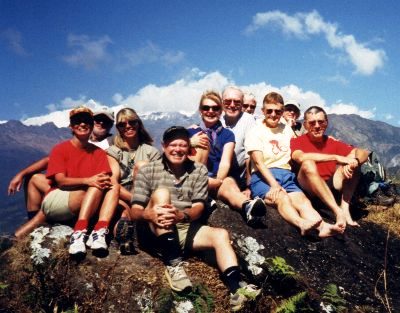| November 21, 1999 Kathmandu Well, here goes the
first episode of our trip. This note will be rather long
as a lot has happened in the last nearly 3 weeks. It has
been a great visit to Nepal and we are both well.
The trip was long but uneventful. We spent 27 hours
travelling to Bangkok, then stayed overnight at the
Bangkok airport. Met up with Derek Anderson & Josie
Hales, Mike & Karyn Rochford, in the airport &
flew to Kathmandu. We had great views of the Himalayas,
including Everest, poking up through the clouds, then
flew through the green hills surrounding the Kathmandu
valley. We were met by Gord Konantz from Everest Trekking
at the airport & transferred to the Kathmandu Guest
House. Gord had returned from a trek to Bhutan that had
started out in pouring rain and then had to turn around
because of snow covered mountain passes. Nevertheless,
everyone had a great time & returned safely. He told
us the monsoons had lasted longer than usual, causing his
problems but that the weather has been great ever since
& we were coming at just the right time. In the
afternoon we got re-acquainted with Kathmandu, dodging
many vehicles, none of which use pollution control
devices, people & cows. Even so, the city is
relatively easy to get around & is not, according to
Josie, half as bad as Bangkok.
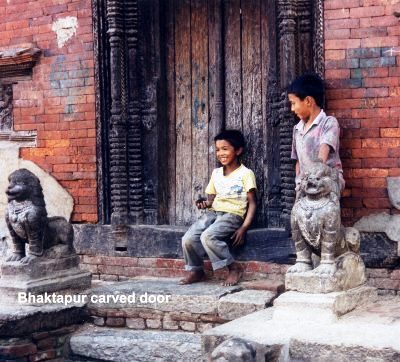 The 2 other couples, Pam Bendall & Brian Haley
from Vancouver & Ian MacLean & Pat Smith from
Saint John arrived that night from Hong Kong. We were all
up bright & early the next day to board mini vans for
an overnight in the mountain resort of Nagarkot. We
stopped en route for a visit to the
ancient town of Baktapur. The
town is mostly Hindu & still observes the caste
system. The highest castes live in the center of town
& progresses from there. Each caste specializes in a
trade, & they are known for intricate wood carving of
windows & doorways, copper pots and wool dying. We
hired a young local guide for the sum of 150 Rupeas (3
CAD) & he stayed with us for 2 hours. Got back in the
minibuses, stopping at a small restaurant on a hilltop at
Nagarkot for a Nepali lunch, then walked a short distance
uphill to the Fort hotel. We all followed Ray over
mountain cow paths in the afternoon to explore the area
& enjoy the clean air after the noise & pollution
of Kathmandu. The next morning we all got an early wakeup
call to The 2 other couples, Pam Bendall & Brian Haley
from Vancouver & Ian MacLean & Pat Smith from
Saint John arrived that night from Hong Kong. We were all
up bright & early the next day to board mini vans for
an overnight in the mountain resort of Nagarkot. We
stopped en route for a visit to the
ancient town of Baktapur. The
town is mostly Hindu & still observes the caste
system. The highest castes live in the center of town
& progresses from there. Each caste specializes in a
trade, & they are known for intricate wood carving of
windows & doorways, copper pots and wool dying. We
hired a young local guide for the sum of 150 Rupeas (3
CAD) & he stayed with us for 2 hours. Got back in the
minibuses, stopping at a small restaurant on a hilltop at
Nagarkot for a Nepali lunch, then walked a short distance
uphill to the Fort hotel. We all followed Ray over
mountain cow paths in the afternoon to explore the area
& enjoy the clean air after the noise & pollution
of Kathmandu. The next morning we all got an early wakeup
call to
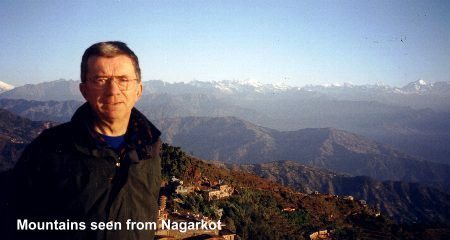 get up at dawn to view the sun come over
the mountains from the roof of the Hotel. This is a
deservedly popular event as the Annapurna, Langtang,
Manaslu & Everest ranges can be seen bathed in a
golden, pink light. Even sitting & standing on an
unprotected narrow rooftop was worthwhile. Came own for
breakfast & a walk over to another ridge. Visited
another hotel, the Farmhouse, which has new luxury units,
a small chorten (a Buddhist prayer site) & a
meditation room overlooking the valley. Derek immediately
made plans to stay there & get over jet lag instead
of Bangkok, where he & Josie spent a few nights this
trip. \par \par Returned to Kathmandu after lunch, packed
our green bags & had our weigh in in the hotel garden.
We are allowed 15 K or 35 lbs, including our sleeping
bags, thermarest mattresses & school supplies we all
brought to give out on the trail. We all passed. Met up
with 3 other groups returning from their treks. Another
Bhutan group also had problems with snow & the trek
to Gokyo Ri, which we did 4 years ago, made it, but
climbed the Ri in snow. Once again, all trips were highly
successful & everyone was full of talk about their
experiences. get up at dawn to view the sun come over
the mountains from the roof of the Hotel. This is a
deservedly popular event as the Annapurna, Langtang,
Manaslu & Everest ranges can be seen bathed in a
golden, pink light. Even sitting & standing on an
unprotected narrow rooftop was worthwhile. Came own for
breakfast & a walk over to another ridge. Visited
another hotel, the Farmhouse, which has new luxury units,
a small chorten (a Buddhist prayer site) & a
meditation room overlooking the valley. Derek immediately
made plans to stay there & get over jet lag instead
of Bangkok, where he & Josie spent a few nights this
trip. \par \par Returned to Kathmandu after lunch, packed
our green bags & had our weigh in in the hotel garden.
We are allowed 15 K or 35 lbs, including our sleeping
bags, thermarest mattresses & school supplies we all
brought to give out on the trail. We all passed. Met up
with 3 other groups returning from their treks. Another
Bhutan group also had problems with snow & the trek
to Gokyo Ri, which we did 4 years ago, made it, but
climbed the Ri in snow. Once again, all trips were highly
successful & everyone was full of talk about their
experiences.
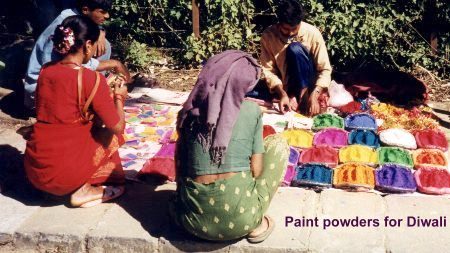 We left the next morning Nov 5 in minivans for our 9
day trek. Took the main highway to India, a 2 lane road
that twists & turns over a mountain pass. The trucks
& busses are all gaily painted & decorated by
their owners & look to be at least 20 years old.
Several had the slogan 'Blow horn please' on the rear,
with good reason, as that is the only way you know
another vehicle is approaching around some of the curves.
Along with the motorized traffic, there are still
bicycles, cattle, goat herds & people sharing the
roadway. All of this overlooking a river far below us. We
made it to our lunch stop in a market town. We were all
glad a box lunch had been provided, as the local
sanitation was more than suspect. We shared the garden
patio lunch spot with locals, dogs and a small buddhist
monastery complete with monks observing noontime prayers.
After lunch, we turned off the main road and started
climbing to the town of Gorkha, another colourful market
town built on the
side of a mountain. Finally we all piled
out & met our guides & porters, put on our hiking
boots & climber stairs for about an hour to visit the
fortress palace protecting the valley. This was the home
of a Shah hundreds of years ago who at one time ruled
most of Nepal & is an ancestor of the current King.
The palace covered in wood carvings on the roof trusses,
many of which depicted pornograhic scenes. The palace
temple courtyard had been the site of goat sacrifices
just the previous week for one of the many Hindu
festivals. We left the next morning Nov 5 in minivans for our 9
day trek. Took the main highway to India, a 2 lane road
that twists & turns over a mountain pass. The trucks
& busses are all gaily painted & decorated by
their owners & look to be at least 20 years old.
Several had the slogan 'Blow horn please' on the rear,
with good reason, as that is the only way you know
another vehicle is approaching around some of the curves.
Along with the motorized traffic, there are still
bicycles, cattle, goat herds & people sharing the
roadway. All of this overlooking a river far below us. We
made it to our lunch stop in a market town. We were all
glad a box lunch had been provided, as the local
sanitation was more than suspect. We shared the garden
patio lunch spot with locals, dogs and a small buddhist
monastery complete with monks observing noontime prayers.
After lunch, we turned off the main road and started
climbing to the town of Gorkha, another colourful market
town built on the
side of a mountain. Finally we all piled
out & met our guides & porters, put on our hiking
boots & climber stairs for about an hour to visit the
fortress palace protecting the valley. This was the home
of a Shah hundreds of years ago who at one time ruled
most of Nepal & is an ancestor of the current King.
The palace covered in wood carvings on the roof trusses,
many of which depicted pornograhic scenes. The palace
temple courtyard had been the site of goat sacrifices
just the previous week for one of the many Hindu
festivals.
Our camp site that night was only 10 minutes away and
the porters had already set up the tents & the cook
staff had warm orange juice ready for us. We were glad of
the juice as the temperature was summer warm & we
were hot from the climb. This was the kind of daytime
weather we ended up experiencing the rest of the trip, so
everyone wore sun hats, shorts & t-shirts during the
day & applied lots of sun block. Each of our camp
sites had a
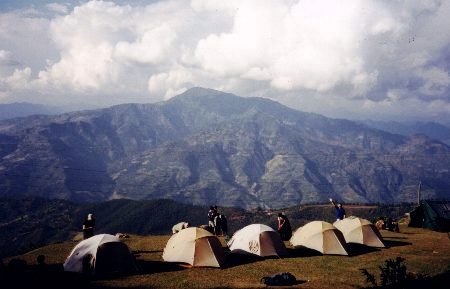 beautiful view of the surrounding
mountains. The Anapurna, Langtang and Manaslu ranges were
always clearly visible in the morning and then gradually
covered up in clouds in the afternoon, although the area
we hiked in remained clear. We started a ritual of
watching the sun go down in the late afternoon, but
wearing our warm clothing, as the temperature dropped
quickly without the sun's warmth. After our supper at 6
PM, we managed to stay awake long enough to play some
cribbage & bugger bridge (some people call it 'O
Shit'). A late night for us was 9 PM. Thank goodness the
sleeping bags and tents always kept us toasty warm so we
all slept comfortably. We were wakened at 6 AM in the
morning by the staff bringing tea. Then we packed our
bags, and when the washing water was delivered, had a
sponge bath in the tent. This works surprisingly well.
Breakfast was porridge, eggs, toast or pancakes, tea,
coffee or hot chocolate. Enough to sustain us for our
morning walk that started before 8 AM. We hiked every day
up and down beautiful hills covered with terraced farms
with crops of rice or millet. There was lots of activity
as the rice harvest was going on using only hand labour
& ancient methods. Every small hamlet we passed
through brought out the children to wish us 'Namaste'
which we answer with our hands held together in a good
luck prayer. We never saw any other trekkers the whole
time as this is not a popular route. This was great for
us as the villages were all friendly without being pesky,
begging for pens or bonbons. Usually we hiked 3 hours or
more in the morning, stopping for 1.5 hours for a hot
lunch cooked by the kitchen staff. We had a tarpaulin
spread on the grass and started with hot orange or lemon.
We always had a good lunch of pita type bread, sometimes
canned tuna or pilchers or salami, vegetables & fruit
for dessert. It was amazing how hungry we all were. After
lunch we walked for 2 more hours on average, often
stopping to take pictures and let the porters or cook
staff pass us. These small men carry an amazing load. The
porters carrying our green bags each had 2, plus our tent
and there own pack or bedroll, approx (50 K) 100 - 110
lbs all tied together and supported by a headband. This
only wearing flip flops on their feet. beautiful view of the surrounding
mountains. The Anapurna, Langtang and Manaslu ranges were
always clearly visible in the morning and then gradually
covered up in clouds in the afternoon, although the area
we hiked in remained clear. We started a ritual of
watching the sun go down in the late afternoon, but
wearing our warm clothing, as the temperature dropped
quickly without the sun's warmth. After our supper at 6
PM, we managed to stay awake long enough to play some
cribbage & bugger bridge (some people call it 'O
Shit'). A late night for us was 9 PM. Thank goodness the
sleeping bags and tents always kept us toasty warm so we
all slept comfortably. We were wakened at 6 AM in the
morning by the staff bringing tea. Then we packed our
bags, and when the washing water was delivered, had a
sponge bath in the tent. This works surprisingly well.
Breakfast was porridge, eggs, toast or pancakes, tea,
coffee or hot chocolate. Enough to sustain us for our
morning walk that started before 8 AM. We hiked every day
up and down beautiful hills covered with terraced farms
with crops of rice or millet. There was lots of activity
as the rice harvest was going on using only hand labour
& ancient methods. Every small hamlet we passed
through brought out the children to wish us 'Namaste'
which we answer with our hands held together in a good
luck prayer. We never saw any other trekkers the whole
time as this is not a popular route. This was great for
us as the villages were all friendly without being pesky,
begging for pens or bonbons. Usually we hiked 3 hours or
more in the morning, stopping for 1.5 hours for a hot
lunch cooked by the kitchen staff. We had a tarpaulin
spread on the grass and started with hot orange or lemon.
We always had a good lunch of pita type bread, sometimes
canned tuna or pilchers or salami, vegetables & fruit
for dessert. It was amazing how hungry we all were. After
lunch we walked for 2 more hours on average, often
stopping to take pictures and let the porters or cook
staff pass us. These small men carry an amazing load. The
porters carrying our green bags each had 2, plus our tent
and there own pack or bedroll, approx (50 K) 100 - 110
lbs all tied together and supported by a headband. This
only wearing flip flops on their feet.
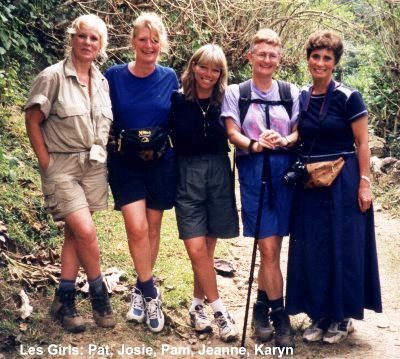 |
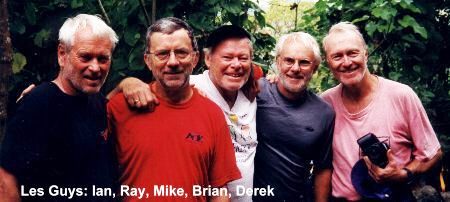 |
Our
gang soon discovered that beer could be purchased in the
small towns, so pre-dinner cocktails were held in Haley's
bar, to honour the instigator, Brian Haley, with our
chairs set up in a semi circle positioned to watch the
sunset. A typical dinner was either a traditional Nepali
Dhal Bhat (rice & lentils), cooked vegetables, flat
breads & dessert, or a tuna pizza, or a great
spaghetti dinner. We even had pie a few nights, once
apple & once banana. We called the cook in several
times to congratulate him on our meals. We camped the 2nd
night next to the Durandi Khola (river) which was warm
enough the wash our clothes and ourselves as long as you
made sure you did not get into the very strong current.
Unfortunately, I got sick overnight. Must have caught a
bug despite careful washing of hands before each meal and
drinking only specially boiled water & food from our
staff. Not fun while camping to have diahhrea & throw
up your dinner, but I was recovered sufficiently to
continue the trek in the morning. Because the trail was
uphill from the river, one of our Sherpa guides carried
my day pack along with his own pack. They were always
willing to provide that service & several of us took
advantage of it when knees or joints were sore. We all
agreed that the staff took excellent care of us, enabling
us to thoroughly enjoy the trek, despite some minor colds.
At our lunch stop at a local school, there was an old
man smoking hashish. Ian wanted a walking stick & the
man carved him one from a tree branch & presented it
to him. This became Ian's favourite souvenir. On the way
up the mountain we passed the first of a few local stills
making Rakshi, a local drink made from millet & corn
that must be pure alcohol. Did not look tempting.
That night we camped in a school yard. It was the
start of the Diwali festival, a major Hindu festival when
everyone returns to their home & the schools are
closed for a week. There are 5 nights of ceremonies &
dancing as well. Many of the villagers appeared to watch
us set up our tents & several come to practice their
english. We visited with a young man who was a teacher in
a neighbouring school. He offered to provide us with
traditional musical entertainment after supper so we
agreed. We also gave him a lot of our school supplies to
be divided between the schools. We also signed their
guest book, the first group to do so in 1999, and made a
small donation to their community. This was repeated in a
few other villages, There is no social security system in
Nepal & the sanitation is very primitive. Some of the
communities are attempting to improve & we
acknowledge this by making small donations to their cause.
That night was the first of about 4 dances we watched.
This group was quite amateurish, but had a drum, bell
cymbals & a flute. The group was only boys & men,
no women & some of them were quite talented. Each
group is given a donation of some money (max 500 R) which
is presented on a platter with a candle & flowers.
Some of the groups, including the first, presented us
with garlands of marigolds for good luck.
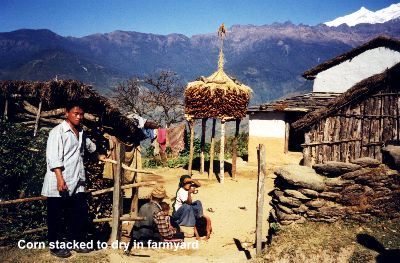 We
stayed 2 nights at one spot near a medium sized village,
arriving at lunch time. Some of us took the afternnon
off, while others went for a walk down to another town.
They visited another Rakshi still & Ray brought some
back in his small water bottle. He tried a sip & so
did some others, but no one could stand it, so Ray gave
it to Rinji, our Sirdar (head guide) to give to whomever
wanted it. We discovered their local washing spot, which
was located in a wooded grotto with a pipe bringing water
into a concrete U shaped wash area. We all brought our
clothes & washed them & ourselves, sharing the
facilities with local women gathering water in jugs &
washing clothes. The locals also danced for us after
supper. This group was mostly young girls, who were all
shy but quite graceful. They had no instruments, but all
sang along. I am told these folk dances are very popular
with the young people. The second night we were there, we
could hear the sound of the villagers singing &
dancing all night long. It turns out this was the height
of the festival & a few of our porters joined them.
In fact 2 partied so long they could not work in the
morning, so they were sent home & the other porters
had to carry even greater loads. We
stayed 2 nights at one spot near a medium sized village,
arriving at lunch time. Some of us took the afternnon
off, while others went for a walk down to another town.
They visited another Rakshi still & Ray brought some
back in his small water bottle. He tried a sip & so
did some others, but no one could stand it, so Ray gave
it to Rinji, our Sirdar (head guide) to give to whomever
wanted it. We discovered their local washing spot, which
was located in a wooded grotto with a pipe bringing water
into a concrete U shaped wash area. We all brought our
clothes & washed them & ourselves, sharing the
facilities with local women gathering water in jugs &
washing clothes. The locals also danced for us after
supper. This group was mostly young girls, who were all
shy but quite graceful. They had no instruments, but all
sang along. I am told these folk dances are very popular
with the young people. The second night we were there, we
could hear the sound of the villagers singing &
dancing all night long. It turns out this was the height
of the festival & a few of our porters joined them.
In fact 2 partied so long they could not work in the
morning, so they were sent home & the other porters
had to carry even greater loads.
Our next campsite was in a valley where the sun
disappeared even earlier than usual & the temperature
was the coldest yet. Once again we were entertained by
the locals, so we kept warm by using our water bottles,
which are filled with boiled water after each supper, as
hot water bottles, both while watching the dancing &
later in our sleeping bags. This group got us all up
dancing which was a good laugh, both for them & us.
They also gave us marigold garlands, which we attached to
our day packs.
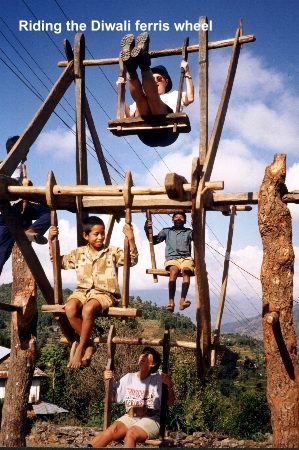 On the trail that day we passed a giant
wooden ferris wheel, that some of the local children were
playing on. All of us & some of our guides took turns
as well. There were 4 seats and was turned by 2 boys
standing on wooden side supports pushing the wheel around.
It was lots of fun, even if it was somewhat rickety. That
night we camped in another school yard. This time all the
children in the area were there playing with a soccer
ball and having a spirited & noisy card game. These
kids were just like their parents, as they were playing
for money. Gambling is a national sport. The kids were
finally shooed away, which was good as Pat came down with
a severe case of indigestion, resulting in her vomiting
most of the night. Ian, her parter was extremely
solicitous and the guides were there to help all night.
Thank goodness, after loading up on immodium &
rehydration medications, Pat was recovered enough to trek
out the next morning & did not have another
recurrence. On the trail that day we passed a giant
wooden ferris wheel, that some of the local children were
playing on. All of us & some of our guides took turns
as well. There were 4 seats and was turned by 2 boys
standing on wooden side supports pushing the wheel around.
It was lots of fun, even if it was somewhat rickety. That
night we camped in another school yard. This time all the
children in the area were there playing with a soccer
ball and having a spirited & noisy card game. These
kids were just like their parents, as they were playing
for money. Gambling is a national sport. The kids were
finally shooed away, which was good as Pat came down with
a severe case of indigestion, resulting in her vomiting
most of the night. Ian, her parter was extremely
solicitous and the guides were there to help all night.
Thank goodness, after loading up on immodium &
rehydration medications, Pat was recovered enough to trek
out the next morning & did not have another
recurrence.
The next morning we passed a giant swing which is
built for the Diwali festival. It is constructed of 4 20
ft long bamboo poles tied to gether at the top and is
usually situated right over the main path. The swing is a
rope of home made of twisted vines, sort of like sisal,
with a twig seat. I tried it out & broke the seat but
got a small ride. The sherpa guides all decided to take a
break & go for a ride, going high upinto the air. I
guess we are all kids at heart.
The last walk was 3 hours down the hills & through
a valley where we watched entire families out harvesting
their crops. We stopped to take a photo of one group
using a team of 6 cows tied together in a line around a
pole, like the ice capades crack the whip. The cows
circled the pole beating down the rice stalks the
eventually become a circular hay stack used for cattle
feed. Others were beating the rice stalks manually to
remove the grain. The head of the family came over to us
as we rested and introduced himself & asked if we
could send him a copy. We had him write his name &
address & will try to do so.
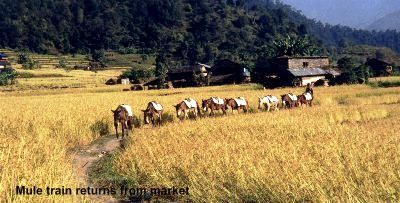 It was
warmer than ever when we reached our final campsite on a
cliff over looking a river so we all put on bathing
suits, with shorts over, and went down to the river to
bathe & wash more clothes. The water was very cold
& the current was swift, but we managed to get
everything more or less clean. That afternoon we had the
presentation ceremony for our staff. We gave each person
a tip roughly equivalent to their entire wages as well as
some used clothing, pens & a Canada pin. The clothes
are divided into roughly equal piles, each numbered with
chalk & then numbers are drawn by each person. Of
course, there is furious trading of the clothes
afterwards. The next morning we crossed a suspension
bridge to the town & the main road on the other side
where a bus was waiting to take us to our next stop, the
Chitwan jungle. It was
warmer than ever when we reached our final campsite on a
cliff over looking a river so we all put on bathing
suits, with shorts over, and went down to the river to
bathe & wash more clothes. The water was very cold
& the current was swift, but we managed to get
everything more or less clean. That afternoon we had the
presentation ceremony for our staff. We gave each person
a tip roughly equivalent to their entire wages as well as
some used clothing, pens & a Canada pin. The clothes
are divided into roughly equal piles, each numbered with
chalk & then numbers are drawn by each person. Of
course, there is furious trading of the clothes
afterwards. The next morning we crossed a suspension
bridge to the town & the main road on the other side
where a bus was waiting to take us to our next stop, the
Chitwan jungle.
|
